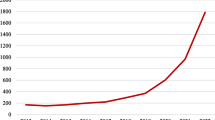Abstract
This paper first explains the need to define subfields of science by means of “filters” that selectively retrieve papers from a database, and then describes how such filters are constructed and calibrated. Good filters should have precision and recall of the order of 90% so as to be representative of a subfield; they are created by an interactive partnership between an expert in the subject and a bibliometrician. They are based primarily on the use of title keywords, often in combination rather than singly, and specialist journals. Their calibration depends on experts marking lists of papers extracted by the filter as relevant, don't know or not relevant. This allows the actual size of a subfield to be estimated and hence the relative importance accorded to it within a major field of science. It permits organisations and countries to see their contributions to individual scientific subfields in detail.
Similar content being viewed by others
References
Bordons, M., Gomez, I., Fernandez, M. T., Zulueta, M. A., Mendez, A. (1996), Local, domestic and international scientific collaboration in biomedical research.Scientometrics, 37: 279–295.
Bordons, M., Zulueta, M. A. (1997), Comparison of research team activity in two biomedical subfields.Scientometrics, 40: 423–436.
Bourke, P., Butler, L. (1998), Institutions and the map of science: matching university departments and fields of research.Research Policy, 26: 711–718.
de Bruin, R. H., Moed, H. F. (1993), Delimitation of scientific subfields using cognitive words from corporate addresses in scientific publications.Scientometrics, 26: 65–80.
Lewison, G. (1991), The scientific output of the EC's Less Favoured Regions.Scientometrics, 21: 383–402.
Lewison, G. (1996), The definition of biomedical research subfields with title keywords and application to the analysis of research outputs.Research Evaluation, 6: 25–36.
Lewison, G. (1998), Gastroenterology research in the United Kingdom: funding sources and impact.Gut, 43: 288–293.
Pestaña, A. (1992), Spanish performance in life sciences. A comparative appraisal of the scientific production of Spain and five other European countries in 1989.Scientometrics, 24: 95–114.
Schwartz, S., Hellin, J. L. (1996), Measuring the impact of scientific publications. The case of the biomedical sciences.Scientometrics, 35: 119–132.
Ugolini, D., Parodi, S., Santi, L. (1997), Analysis of publication quality in a cancer research institute.Scientometrics, 38: 265–274.
Author information
Authors and Affiliations
Rights and permissions
About this article
Cite this article
Lewison, G. The definition and calibration of biomedical subfields. Scientometrics 46, 529–537 (1999). https://doi.org/10.1007/BF02459609
Received:
Issue Date:
DOI: https://doi.org/10.1007/BF02459609




